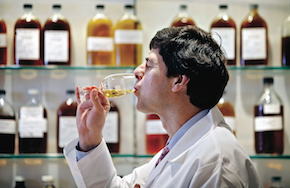Boffin in a white coat
DCL (Distillers Company Limited, forerunner to what is now Diageo) was looking for research scientists. He applied and went to work at Menstrie, near Stirling in Scotland, where DCL had a large, bonded warehouse, yeast factory and research centre.
“I was a boffin in a white coat. I was working with Jim Beveridge, who is now Johnnie Walker’s master blender. I had been concentrating on malting, mashing and fermentation. But Jim was the person who homed in on maturation and oak management. He elevated the absolute importance of wood.
“I could have continued as a boffin but I was looking for an opportunity for promotion and progression. I went on to work with a great team, Ian Miller (now Glenfiddich’s global brand ambassador) and Gordon Donoghue (he was at Bushmills but is now back at Diageo as operations director, distilling and maturation).
In 1993 Lumsden became assistant manager at United Distillers’ Burghead and Roseisle operations (Then owned by Guinness. In 1997 Guinness merged with Grand Metropolitan to create Diageo). Lumsden, ever appreciative of former colleagues, says he worked with the “dream team of Alan Barclay and Andy Cant (now Cardhu’s group manager).
“Alan was great on strategy while Andy was good on the PC with things such as scheduling, while I liked rolling up my sleeves and getting stuck in. It was a great job and I have certain regrets [he pauses but isn’t forthcoming] but Glenmorangie was looking for a distribution manager. I was going from being a medium fish in a very big pond to Glenmorangie, where I was left to my own devices. I had complete responsibility for all the whisky and I had a great team of blenders, including Rachel Barrie, who is now master blender at Morrison Bowmore,” says Lumsden.
Now 55, Lumsden acknowledges that Brendan McCarron, head of maturing whisky stocks at Glenmorangie, is his heir apparent, or “son of Bill” as he puts it. On McCarron’s Linkedin profile, he states that among his many responsibilities listed, the first is: “Learning from Dr Bill Lumsden… how the whisky creation and maturing stocks department at Glenmorangie company runs, with a particular emphasis on understanding the stocks laid down and developing new expressions of Glenmorangie and Ardbeg.” Lumsden says: “Brendan is a fellow west coaster (of Scotland). He’s a chemical engineer with a killer discipline.” He obviously approves of those attributes.
Lumsden acknowledges the significance of Glenmorangie’s takeover by LVMH at the end of 2004. He says the company was basically on its knees prior to the acquisition. The French giant has pumped in investment to restore the operation and build its two major brands Glenmorangie and Islay single malt, Ardbeg.
When pushed to name the expressions he is most proud of, Lumsden goes for Glenmorangie’s Signet, which is made using heavily roasted ‘chocolate’ malt, and Ardbeg Uigeadail, World Whisky of the Year in Jim Murray’s Whisky Bible 2009. Lumsden coined the name, which is the loch that supplies the peat-laden water used to make Ardbeg.
By scotch whisky standards Lumsden is quite open and forthright in his opinions. On the increasing trend towards non-age statements to protect ageing stocks, he says: “As long as people act in a responsible manner – I cannot imagine a brand owner wanting to damage the image of their brand. It was inevitable as no company has infinite aged whiskies. This is nothing new to us. Ardbeg Uigeadail has no age statement. We were taking whiskies from the 1970s, eight to 30-year-old. We are not doing that now as it was not sustainable.”




